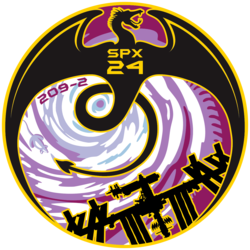 CRS-24 mission docked to ISS | |
| Names | SpX-24 |
|---|---|
| Mission type | ISS resupply |
| Operator | SpaceX |
| COSPAR ID | 2021-127A |
| SATCAT no. | 50318 |
| Mission duration | 34 days, 10 hours, 57 minutes |
| Spacecraft properties | |
| Spacecraft | Cargo Dragon C209 |
| Spacecraft type | Cargo Dragon |
| Manufacturer | SpaceX |
| Launch mass | 6,000 kg (13,000 lb) |
| Payload mass | 2,989 kg (6,590 lb) |
| Dimensions | 8.1 m (27 ft) (height) 4 m (13 ft) (diameter) |
| Start of mission | |
| Launch date | 21 December 2021, 10:07:08 UTC [1] |
| Rocket | Falcon 9 Block 5 B1069-1 |
| Launch site | Kennedy Space Center, LC-39A |
| End of mission | |
| Recovered by | MV GO Searcher |
| Landing date | 24 January 2022, 21:05 UTC [2] |
| Landing site | Gulf of Mexico |
| Orbital parameters | |
| Reference system | Geocentric orbit |
| Regime | Low Earth orbit |
| Inclination | 51.66° |
| Docking with International Space Station | |
| Docking port | Harmony zenith |
| Docking date | 22 December 2021, 08:41 UTC |
| Undocking date | 23 January 2022, 15:40 UTC |
| Time docked | 32 days, 6 hours, 59 minutes (achieved) |
| Cargo | |
| Mass | 2,989 kg (6,590 lb) |
| Pressurised | 2,081 kg (4,588 lb) |
| Unpressurised | 908 kg (2,002 lb) |
 SpaceX CRS-24 mission patch | |
SpaceX CRS-24, also known as SpX-24, was a Commercial Resupply Service mission to the International Space Station launched on 21 December 2021, at 10:07:08 UTC. [3] [4] The mission is contracted by NASA and is flown by SpaceX using a Cargo Dragon. This is the fourth flight for SpaceX under NASA's CRS Phase 2 contract awarded in January 2016. [5]





